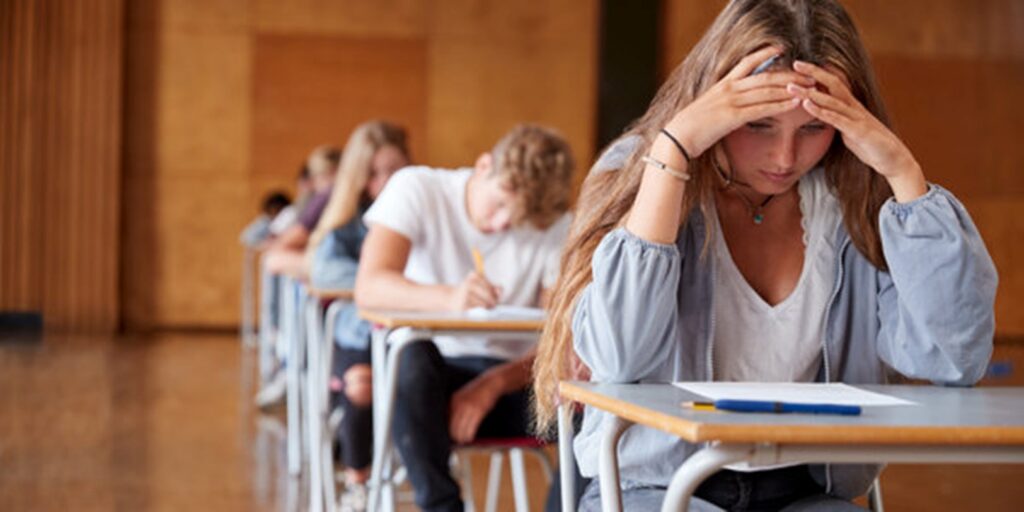America has a new national emergency; child and adolescent mental health rates have plummeted due to the COVID-19 pandemic. Approximately 140,000 children have lost a primary or secondary caregiver since the start of 2020, impacting their mental health and academic performance. Anxiety and depression have also increased, as well as the demand for mental health services in schools throughout the country.
What’s leading to the drop in student mental health? Students are struggling to be optimistic about an uncertain future after facing disruption to their family, community, and social circles. Many students have been isolated from their peers as they experience grief and major changes to their daily routine without a strong support system.
Being aware of the challenges students are facing at home is the first step to showing support as they learn to navigate what is being referred to as “the new normal.” The effects of the pandemic cannot be reversed, but they can be lessened by identification and accommodation for those experiencing grief and trauma.
Alpine Academy Utah reviews the latest findings on student mental health in the US.
YouthTruth Student Survey Measures Stress and Anxiety
Non-profit YouhTruth published a recent survey called Students Weigh In: Learning & Well-Being During COVID-19 to determine the effects of the pandemic on their well-being. The study is a follow-up to the first study they published in the spring of 2020, which focused on distant learning through Zoom during lockdown.
Now, students are sharing opinions on what attending schools has been like since restrictions have decreased and in-person or hybrid learning have become possible. And the results aren’t reassuring. The report notes that feeling depressed, anxious, or stressed is the number one obstacle to learning.
These rising mental health obstacles disproportionately affected Hispanic, Latinx, multiracial, and Black or African American students who have a harder time accessing mental health services than white students. Male students also reported higher overall well-being than female and non-binary or gender-non-conforming students, who may be more susceptible to developing anxiety.
Stress and anxiety are not new topics among Generation Z. Earlier research indicated that the worsening health crisis in young students is linked to increased pressure to perform and concerns about the future. Many children and teens are experiencing a greater urgency to earn good grades and attend a four-year degree or career after high school graduation without having the proper funding or resources to do so.
However, these numbers skyrocketed during the 2020 school year. School closures and limited access to resources made the idea of achieving an ideal education much more difficult for students.
The report also shows that students don’t speak highly of virtual learning: they feel overworked with assignments irrelevant to course objectives.
YouthTruth’s survey raises questions about the prioritization of meeting due dates and benchmarks, even when students are coping with high stress and coping with family members who are affected by illness, job loss, and financial stress due to COVID-19.

School District Sees Risk of Suicide Double
Depression has been a growing concern for adolescents and teens since the rise of the internet, and we saw the effects of increased suicide rates among the millennial generation. Now, Gen Z is raising the rate of suicide in America higher than anyone expected. In San Antonio, Texas, the Somerset Independent School District saw suicide assessments double, leading to nationwide concerns about whether the numbers will keep rising.
Educators believe that the signs of rising suicide risk would be more obvious in person. However, many students are still opting for virtual learning, which reduces the chance that educators will notice and report symptoms of depression, anxiety, and suicidal behavior.
Substance abuse trends changed throughout the pandemic as students grappled with educational disruptions and family hardships. Compared to pre-pandemic statistics, alcohol use declined in the first six months, but nicotine and prescription drug abuse rose.
Educators believe that as more students return to in-person learning, we will see a decrease in suicidal behavior and substance abuse. However, there’s no confirmation of when we can expect the classroom to return to normal.
Students Still Struggling With Grief
According to recent research published in the journal Frontiers in Psychology, students are having difficulty processing grief during the pandemic while feeling obligated to keep up with academic and social responsibilities. By studying the effects of COVID-19 related loss on students, Sara Albuquerque and Ana R. Santos concluded that grief has negatively impacted students who are not only grieving the loss of loved ones but because of missed rites of passage, friendships, and school-oriented events and opportunities.
Many children who suddenly lost loved ones were unable to spend time with them before their death, leaving them unable to process the shock. Older children need the most support because they are expected to support other family members at home. The study recommended strengthening outreach from teachers, coaches, or guidance counselors.
Bottom Line
While educators have been struggling to address student mental health issues, there’s now an urgent need to address this crisis and find a solution that lowers depression, anxiety, stress, and substance abuse.
However, many educators do not feel like they are trained to appropriately care for student mental health. Only 15% of teachers feel comfortable addressing the trauma and grief many students are currently experiencing.
Regardless, all of these recent research efforts agree that mental health needs to be monitored and managed at home and in school.

